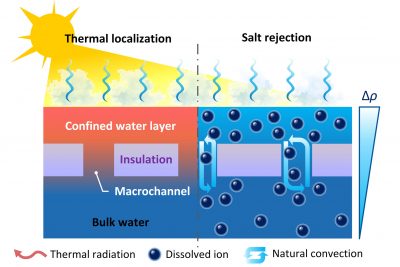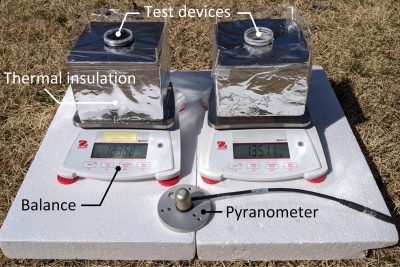Solar desalination could provide $4 drinking water

What can you buy for four dollars these days? The answer could soon be clean drinking water.
A team of researchers in China and the US have developed a domestic-scale solar desalination device sufficient to provide a family’s daily drinking water needs. Once in production, it could cost just US$4.00.
An estimated two-thirds of humanity is affected by shortages of water, and sometimes water that is available is brackish or saline. People cannot drink salty water as their direct source of supply, but it can be made into freshwater in a process called desalination.
Desalination is being used more and more around the world to provide people with necessary freshwater, but many water-scarce regions also face a lack of dependable and affordable electricity. Widespread research efforts have focused on ways to desalinate seawater or brackish water using just solar power.
Here the challenge has been the fouling of equipment caused by a build-up of salt in equipment, which can add complexity and expense.
“The challenge has been the salt-fouling issue, that people haven’t really addressed."
The team of researchers from Massachusetts Institute of Technology (MIT) and Shanghai Jiao Tong University have come up with a solution to the problem of salt accumulation — and in the process developed a desalination system that is both more efficient and less expensive than previous solar desalination methods. The process could also be used to treat contaminated wastewater or to generate steam for sterilising medical instruments at remote clinics, all without any power source other than the sun.
So far, the team has proven the concept using small bench-top prototypes, so the next step will be to scale-up to devices that could have practical applications.

“There have been a lot of demonstrations of really high-performing, salt-rejecting, solar-based evaporation designs of various devices,” said Evelyn Wang, professor of mechanical engineering at MIT. “The challenge has been the salt-fouling issue, that people haven’t really addressed."
Many attempts at solar desalination systems rely on some kind of wick to draw the saline water through the device, but these wicks are vulnerable to salt accumulation and relatively difficult to clean. The team focused on developing a wick-free system instead."
The result is a layered system, with dark material at the top to absorb the heat of the sun, then a thin layer of water above a perforated layer of material, sitting atop a deep reservoir of the salty water such as a tank or a pond. Based on their calculations, a system with a one metre square collecting area is sufficient for a family’s daily drinking water needs. They calculated that the necessary polyurethane materials for a one-square-meter device would only cost about US$4.
First uses are likely to be providing safe water in remote off-grid locations, or for disaster relief after hurricanes, earthquakes, or other disruptions of normal water supplies.

The findings are described in Nature Communications journal, in a paper by Wang, along with MIT graduate student Lenan Zhang and post-doctoral researcher Xiangyu Li. The team also included Yang Zhong, Arny Leroy and Lin Zhao at MIT, and Zhenyuan Xu at Shanghai Jiao Tong University in China. The work was supported by the Singapore-MIT Alliance for Research & Technology, the US-Egypt Science & Technology Joint Fund, and used facilities supported by the National Science Foundation.
